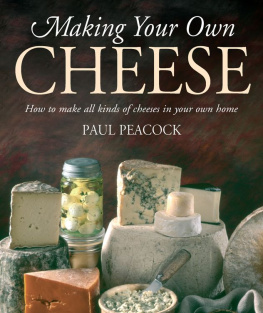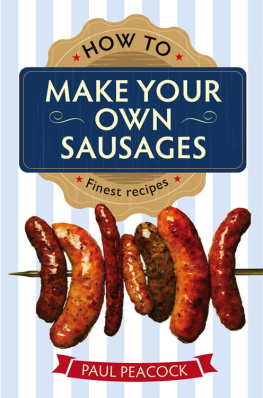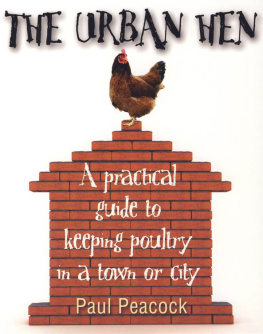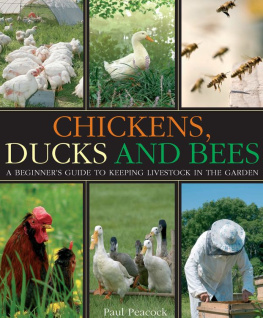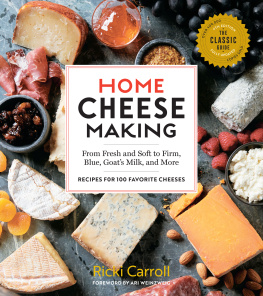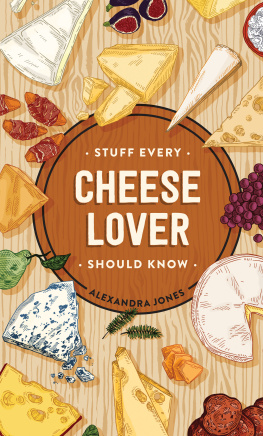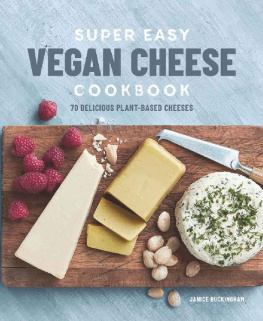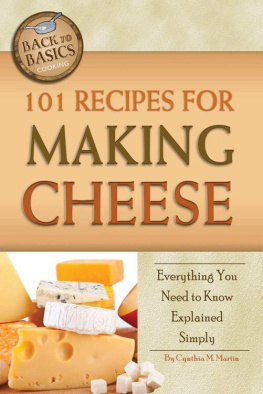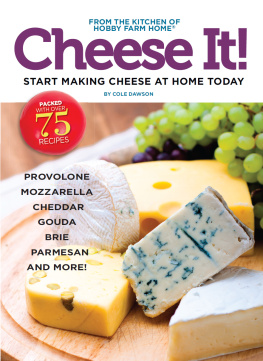At www.howto.co.uk you can engage in conversation with our authors all of whom have been there and done that in their specialist fields. You can get access to special offers and additional content, but most importantly you will be able to engage with, and become a part of, a wide and growing community of people just like yourself.
At www.howto.co.uk youll be able to talk and share tips with people who have similar interests and are facing similar challenges in their lives. People who, just like you, have the desire to change their lives for the better: be it through moving to a new country, starting a new business, growing their own vegetables or writing a novel.
At www.howto.co.uk youll find the support and encouragement you need to help make your aspirations a reality.
You can go direct to www.making-your-own-cheese.co.uk, which is part of the main How To site.
How To Books strives to present authentic, inspiring, practical information in its books. Now when you buy a title from How To Books, you get even more than just words on a page.
A s a child I used to be sent to the shops for what was then termed cooking cheese. It was a kind of Cheddar: slightly hard, full-fat, strongly flavoured, ideal for melting. It was twenty years before I realised I was eating strong Cheddar. What my mother termed eating cheese was Cheshire, which was crumbly. We never saw Stilton or Danish; you simply couldnt buy those in inner-city Manchester.
Thankfully, the arrival of a supermarket opened a new world of opportunities for cheese. We were suddenly exposed to Roqueforts, ricottas, wonderful Edams and Gruyres. Cheese lost its mystique for us, and while it became more commonplace, at the same time certain types remained grand and desired.
Even today, we still dont really understand cheese. We like flavours and textures like many wine-drinkers we know what we like but the step from buying cheese in a supermarket to making your own remains a pretty daunting prospect for most people.
And yet, making cheese is one of those things that, for centuries, humans have done to survive. Its origins stretch right back into the dawn of agriculture. However, it is much more than a mere survival tool. Cheese is one of those foods that make life bearable and to me, real culture is just that: something that makes life bearable.
Which is why, although this book will show you how to make cheeses in many categories, it has only one theme: that cheese should be enjoyed by everyone.
Indeed, cheese is culture at its best.
How it all began
We can only speculate about the consequences and technology that came together to create cheese. On one hand, most people know that if you leave milk for long enough you get a semi-solid, strongly aromatic mass few of us would actually wish to eat. On the other hand, it is quite a leap to work out that these two portions, solid and liquid, separate and that you can wash away the off portion, leaving behind coagulated protein.
Yet the fact that every culture in the world has a simple, basic cheese made in almost the same way suggests a common ancestry. Even the Chinese, who arent noted for dairy products, make a simple cheese called bai, which is similar to Asian paneer, South American quesoblanco and so on. It was in Europe, however, that cheese-making developed into the range of delightful culinary treats we know today.
The development of Brie, for example, is a little miracle in itself. Its manufacture depends on exact temperature management and the application of a fungus during the maturation stage. How eighth-century cheese-makers were able to keep milk at the required temperature, when a variation of just one degree can ruin the cheese, is still unknown, yet they were obviously successful at it so much so that when Holy Roman Emperor Charlemagne first tasted Brie, he asked that the towns taxes be paid not in money, but in cheese.
Whatever its origins, cheese was possibly first mass-produced in Greek times, but the Romans were the true cheese-masters. They preferred smoked cheese, and also invented the cheese press. It wasnt until the fourteenth century that moulds for pressing cheese into specific shapes were invented. In medieval times, monasteries were the major movers in terms of cheese manufacture, and most commonplace cheeses we know today started life in cloistered surroundings. From the Middle Ages onwards, the popularity of cheese exploded exponentially particularly because most royal families gave it as presents to courtiers at Christmas.
Why make your own cheese?
This book is designed for anyone who wants to make cheese for his or her own use not sell it to others. The reason for this is because I believe we will one day have to rely on the skills my grandmother had for our everyday existence.
My grandparents lived modest lives in industrial districts, went to work in an effort to keep the country from the grasp of Nazi Germany, and yet still had time to grow and produce much of their food. Cheese was a fundamental part of their world. When they had cheese melted on grilled bacon with a splash of milk to make the sauce, it was their own cheese they used. Forgive me for sounding pessimistic, but their skills, I believe, are the key to mankinds success in future years.
So my answer to the question Why make your own cheese? is based partly on this concept: that the skills and knowledge humanity has used over generations are just as important today as they were a thousand years ago.
Yet there is something more we have missed out on along the way. If you make your own cheese and become proficient at it, you are making a product that is wildly better than anything you could buy in the shops. You know its origin; you know there is nothing in it other than what you put into it; you control its saltiness, additives and flavour. It is your cheese and as such, it is better than any other.
Is it cheaper?
Not if you have to buy the milk, but it can be. It will, however, certainly be cheaper than those posh cheeses you purchase at the shops. You can make a very good Boursin alternative with very little fuss, for example, and it will be your cheese.
When is the best time to make cheese at home?
Summer makes for more even temperatures; consequently maintaining milk temperature is easier. But nowadays, the best time to make cheese at home is anytime you fancy cheese!
Types of cheese
Making Your Own Cheese contains recipes for the following cheese types, described here in brief but elaborated on in later chapters. Their successful manufacture depends just as much on your ability to store and mature them as on each recipes heat treatments and starter requirements.
While ancient cheese-makers relied on microbes from their locality, modern cheese-making uses microbes purchased in a sachet. The difference between a creamy Lancashire and a Stilton is due to the starter and microbes used in the process, but centuries ago it resulted simply because there were different microbes in the environment where Stilton was made than were present in Lancashire. Microbes aside, however, all cheeses can be divided into the groups listed below.
Fresh
Fresh cheese is the simplest type to make. Milk is soured, either with rennet or sometimes with lemon juice, and the resulting whey is allowed to drain away naturally. The mass, or curd, is simply collected in a cheesecloth and washed to remove as much of the whey as possible, then salted. Sometimes cream is added, but otherwise this is all thats involved in the process.
Soft cheese
Soft cheeses are made by the action of a starter inoculation and rennet. When the cheese has been made, it is then washed in a fungal solution to achieve its final form. Camembert and Brie are familiar examples of soft cheeses.

